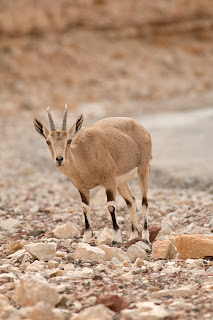Day 13 17.02.2018
Having miss out on the desert survey yesterday, today it was
my turn. The area I was given was the same area we had been last weekend, so I
knew what to expect. The species were much the same as before; Temmincks and
Desert Larks with Spotted Sandgrouse flying overhead. Mourning, Isabelline and
Desert Wheatears completed the common species, whilst two Stone Curlew were a nice
additional surprise. However the route took us on the other side of the road
where we had not been before, into a sandy wadi. There was not a great deal of
birdlife until the end of our route. We had just finished our last count and
were preparing to leave when a flock of c.30 birds flew past us. Small, finch
like birds with an unfamiliar call, plumages a mixture of green and grey; they
could only be Syrian Serins, a species I did not think I would get the chance
to see. Fortunately we followed the flock to where they landed and had
exceptional views of the flock feeding on the desert vegetation. Apparently it’s
the largest flock seen in the region for a few years. A really exciting find.
It was lunchtime when we wrapped up the survey completely.
As feedback from areas began to drift in we were optimisitic of something good
being found. We were lucky that a new group of Thick-billed Larks was found on
our route back, so we decided to call in and have a look. A notoriously tricky
species due to their being extremely mobile, I was not over optimistic, and
even less so after an hour in the wadi yielded no sign, only a nice flock of
Temmincks Larks. However, it was once we had given up and were on our way back
to the car that we finally struck gold, when I stumbled across a group of eight
birds, including a few males. When I picked them up I was initially overcome
with shock, and could only half whistle and stutter to the others that I had
them, but it was no problem as they quickly picked up the birds. They showed
really quite well, and fairly close! It was an awesome encounter!
In the evening we went snorkelling for the first time in a
few days, and to cap off an excellent day I got to see a stingray, more
specifically a Bluespotted Ribbontail Ray. It was a beautiful fish, and my
first wild cartilaginous fish. What an awesome day!
-Syrian Serin
-Desert Agama
-Temmincks Lark
-Thick-billed Lark
Species List:
Ovda: Feral
Pigeon, European Stonechat, Hen Harrier, Spotted Sandgrouse, Stone Curlew,
Desert Wheatear, Desert Warbler, Desert Wheatear, Crested Lark, Temmincks Lark,
Steppe Eagle, Syrian Serin, Desert Lark, Scrub Warbler, Mourning Wheatear,
White-crowned Black Wheatear, Blackstart, Brown-necked Raven, Isabelline Wheatear,
Spanish Sparrow, Rock Martin, Southern Grey Shrike, Laughing Dove, Collard
Dove, Palestine Sunbird, Hoopoe, Spectacled Bulbul, Chiffchaff, House Sparrow,
Graceful Prinia, White Wagtail, Thick-billed Lark, Dorcas Gazelle, Wild Ass, Desert Agama,
Day 14 18.02.2018
Because of my success yesterday, and the lack of success
that the raptor counters suffered with just 10 eagles, I volunteered to take a
shift in the mountains. After an extended absence I returned to High Mountain
hopeful that the lack of eagles the previous day would not be repeated. It was!
I did not see a single eagle, and the only raptors I saw were three Steppe
Buzzards.
However, there was some solace in the fact that I got the
spent most of my time with the Desert Larks that frequent the site, as well as
Hooded Wheatear and on one occasion White-crowned Black Wheatear as well. The
highlight though was when a Nubian Ibex came round to investigate my
watchpoint. It was fearless and rather inquisitive, allowing me to get some
rather nice photos of it.
-White-crowned Black Wheatear
-Nubian Ibex
-Desert Lark
Species List:
High Mountain: Steppe
Buzzard, Scrub Warbler, Hooded Wheatear, Brown-necked Raven, Desert Lark,
White-crowned Black Wheatear, Common Kestrel, Nubian Ibex
Day 14 19.02.2018
It was decided, for whatever reason, that we should have two
counters based in the mountains. As a result I was positioned at Low Mountain where
I got to enjoy a very slow passage of just eight Steppe Eagles. It was not all
tedious though, as we also had passing visits from a Striolated Bunting and the
Hooded Wheatear showed extraordinarily well, possibly even better than it ever
has before.
-Hooded Wheatear
-Striolated Bunting
-Sand Partridge
Species List:
Low Mountain: Steppe
Eagle, Long-legged Buzzard, Hooded Wheatear, White-crowned Black Wheatear,
Striolated Bunting, Barn Swallow, Rock Martin, Pallid Swift, Sand Partridge,
Spectacled Bulbul, Feral Pigeon, Laughing Dove,



















No comments:
Post a Comment